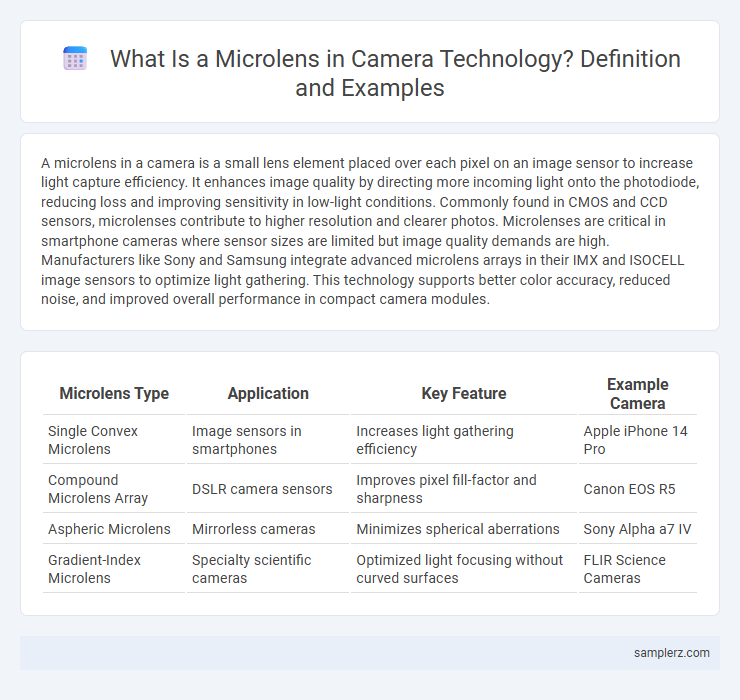A microlens in a camera is a small lens element placed over each pixel on an image sensor to increase light capture efficiency. It enhances image quality by directing more incoming light onto the photodiode, reducing loss and improving sensitivity in low-light conditions. Commonly found in CMOS and CCD sensors, microlenses contribute to higher resolution and clearer photos. Microlenses are critical in smartphone cameras where sensor sizes are limited but image quality demands are high. Manufacturers like Sony and Samsung integrate advanced microlens arrays in their IMX and ISOCELL image sensors to optimize light gathering. This technology supports better color accuracy, reduced noise, and improved overall performance in compact camera modules.
Table of Comparison
| Microlens Type | Application | Key Feature | Example Camera |
|---|---|---|---|
| Single Convex Microlens | Image sensors in smartphones | Increases light gathering efficiency | Apple iPhone 14 Pro |
| Compound Microlens Array | DSLR camera sensors | Improves pixel fill-factor and sharpness | Canon EOS R5 |
| Aspheric Microlens | Mirrorless cameras | Minimizes spherical aberrations | Sony Alpha a7 IV |
| Gradient-Index Microlens | Specialty scientific cameras | Optimized light focusing without curved surfaces | FLIR Science Cameras |
Introduction to Microlenses in Camera Technology
Microlenses in camera technology are tiny lenses integrated on image sensors to enhance light capture efficiency and image resolution. These microlenses focus incoming light onto individual photodiodes, significantly improving sensitivity and reducing noise in low-light conditions. Advances in microlens design contribute to higher dynamic range and sharper image quality in smartphones and digital cameras.
How Microlenses Improve Camera Sensor Performance
Microlenses enhance camera sensor performance by increasing the amount of light each pixel can capture, improving sensitivity and image quality, especially in low-light conditions. By focusing incoming light onto the photodiode, microlenses reduce optical crosstalk and maximize photon collection efficiency. This results in sharper images with better color accuracy and reduced noise, vital for high-resolution sensors in smartphones and digital cameras.
Types of Microlenses Used in Modern Cameras
Modern cameras employ several types of microlenses, including spherical, aspherical, and compound microlenses, each optimizing light capture efficiency and image sharpness. Spherical microlenses are widely used for their ease of manufacturing and effective light focusing on image sensors, while aspherical microlenses reduce optical aberrations and improve image quality, especially in wide-angle lenses. Compound microlenses combine multiple lens elements to enhance depth of field and correct distortions, playing a critical role in smartphone and high-end DSLR cameras for superior performance.
Microlens Arrays: Enhancing Image Quality
Microlens arrays significantly improve image quality by increasing light absorption and reducing optical aberrations in camera sensors. These arrays consist of thousands of tiny lenses that focus incoming light onto photodiodes with higher precision, enhancing low-light performance and sharpness. Advanced applications in smartphone cameras and digital imaging systems rely on microlens arrays to achieve superior resolution and color accuracy.
Role of Microlenses in Smartphone Cameras
Microlenses in smartphone cameras significantly enhance light collection efficiency by directing photons onto the image sensor's photodiodes, improving low-light performance and image clarity. These tiny lenses reduce optical aberrations and increase the effective aperture of each pixel, enabling higher resolution and sharper images. Integrating microlens arrays within the camera module supports advanced features such as phase detection autofocus and computational photography, contributing to superior photo quality in compact mobile devices.
Microlenses in DSLR and Mirrorless Camera Sensors
Microlenses in DSLR and mirrorless camera sensors enhance light capture by directing more photons onto the photodiodes, boosting sensor sensitivity and image quality. These tiny lenses improve low-light performance and reduce noise by maximizing light efficiency across each pixel. Advanced microlens arrays also contribute to faster autofocus and better dynamic range in modern digital cameras.
Microlenses and Low-Light Photography
Microlenses in camera sensors enhance light gathering capabilities by directing more photons onto photodiodes, significantly improving low-light performance. These tiny optical elements reduce stray light and increase sensitivity, enabling clearer and brighter images in dim environments. Advances in microlens design contribute to higher dynamic range and lower noise levels in smartphone and DSLR cameras.
Innovations: Microlenses in Computational Photography
Microlenses integrated in computational photography enhance image quality by precisely directing light onto individual pixels, improving sensor sensitivity and reducing noise in low-light conditions. Innovations like backside-illuminated (BSI) sensors combined with advanced microlens arrays enable higher resolution and better color accuracy in smartphone cameras. These technological advancements optimize light capture and depth mapping, revolutionizing autofocus speed and portrait mode effects in modern digital imaging.
Future Trends: Next-Generation Microlens Solutions
Next-generation microlens solutions in camera technology are leveraging advanced materials like metasurfaces and nanostructured polymers to achieve unprecedented light efficiency and image resolution. Innovations in wafer-level optics enable mass production of microlenses with submicron precision, enhancing autofocus speed and low-light performance in smartphone and automotive cameras. Future microlens developments prioritize integration with artificial intelligence algorithms to dynamically adjust focus and depth of field for superior computational photography outcomes.
Real-World Examples of Microlens Applications in Cameras
Microlens arrays enhance smartphone cameras by improving light absorption and pixel fill factor, leading to sharper images even in low-light conditions. DSLR cameras utilize microlenses to increase sensor efficiency and dynamic range, enabling more accurate color reproduction and better focus precision. Advanced security cameras incorporate microlens technology to capture high-resolution footage with enhanced depth of field and reduced distortion.

example of microlens in camera Infographic
 samplerz.com
samplerz.com